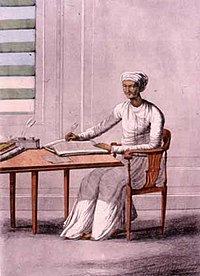Kulin Kayastha

A Kayastha of Calcutta, from a 19th century book
|
|
| Languages | |
|---|---|
| Bengali |
Kulin Kayasthas are a sub-caste of the Kayastha caste in Bengal, India. They are also known as the Kulina Kayasthas.
The Kayasthas are regarded in Bengal, along with the Brahmins, as being the "highest Hindu castes". The Bengali Kayasthas are subdivided into numerous clans in that region, of which the Kulin is a high-ranking example.
The social and religious patterns of Bengal had historically been distinctively different from those in the orthodox Hindu heartland of North India and this impacted on how the caste system developed there. Bengal, being located east of the traditional Aryavarta region between the Ganges and Yamuna rivers, remained insulated from the full impact of Brahminical orthodoxy for many centuries, and the impact of Buddhism remained strong there. During the reign of the Gupta Empire beginning in the 4th century AD, when systematic and large-scale colonization by Aryan Kayasthas and Brahmins first took place, Kayasthas were brought over by the Guptas to help manage the affairs of state. But the influence of Buddhism continued under the Buddhist rulers of the Pala dynasty from the eighth through the eleventh century CE.
It is traditionally believed that at this point, after the decline of the Pala dynasty, a Hindu king, Adisura brought in five Brahmins and their five attendants from Kanauj, his purpose being to provide education for the Brahmins already in the area whom he thought to be ignorant, and revive traditional orthodox Brahminical Hinduism. Multiple accounts of this legend exist, and historians generally consider this to be nothing more than myth or folklore lacking historical authenticity. Likewise, the original varna status of the five attendants, accompanying the Brahmins, according to the legend, is also a subject matter of debate. Majority of sources mention them as Shudra servants, many others refer to them as Kayastha attendants, and very few as Aryan Kshatriya consorts. The tradition continues by saying that these incomers settled and each became the founder of a clan. In the case of the five attendants, each clan was of the Kayastha caste, and these founders are sometimes referred to as the five legendary Kayasthas. According to Swarupa Gupta, "this legend was fitted into a quasi-historical, sociological narrative of Bengal and deployed to explain the realities of caste and sub-caste origins and connections during the late nineteenth and early twentieth century".
...
Wikipedia
